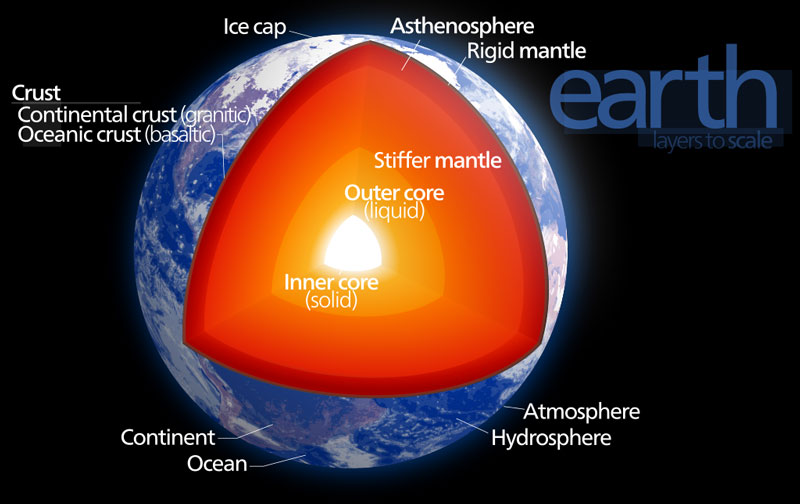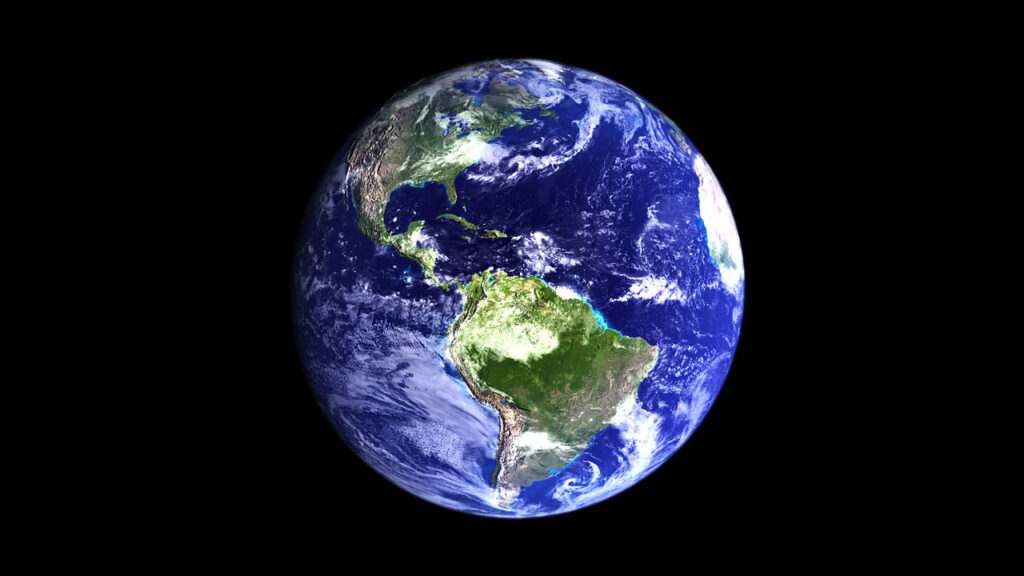- Bowling ball: The Earth has a smoother surface than a bowling ball (if you scale it down to the same size)
- Sunlight: All sunlight reaching Earth is 8 minutes old
- Lightning: There are 8.6 million lightning bolts on Earth every day
- Volcanoes: There are almost 500 volcanoes on Earth. 90% of all volcanic activity takes place in the ocean
- Shape: The earth is not round; it is more of a flattened spheroid
- Tectonics: The continents on Earth move about 2 cm every year (up to 4 cm in some places)
- Highest point: The highest mountain on earth, Mount Everest, is 8,848 meters high
- Deepest point: Earth’s deepest point in the ocean is the Mariana Trench, which is 10,924 meters deep
- Gold: 99% of all Earth’s gold lies in the Earth’s core
- Inner core: The Earth’s inner core is a solid metal sphere that is 5,150 – 6,371 km deep (wide) and 3,300-4,000 degrees hot

Fact: 99% of all Earth’s gold is located in the Earth’s core
More facts about Earth
The human being
- Countries: There are 192 countries on Earth
- Visibility: China’s air pollution is visible from space – but the Great Wall of China is not
- Population: The world’s population is growing by just over 1% and will be 9.2 billion in 2050 (it’s around 7.1 billion today)
- Gravity: Gravity is not the same everywhere on Earth. This means that you don’t weigh the same everywhere
The tide
- Day: A 24-hour day on Earth only lasts 23 hours, 56 minutes and 4 seconds – not 24 hours
- Year: A year on Earth lasts 365 and ¼ days. The quarter days are added together every four years to form a leap year, which lasts 366 days
- Rotation: The earth is moving slower and slower; for every century, 1 milisecond is added (although the delay is not completely smooth)
- Liv: Life (as we know it) has only existed on Earth for 150-200 million years; and since the Earth is around 5 billion years old, this is only about 5-10% of the Earth’s lifespan
- Non-residential: In about 1 billion years, Earth will be uninhabitable for all forms of life due to the increasing heat of the sun
- Water: In about 2 billion years, there will be no water left on Earth; it will have evaporated
- The future of the earth: Earth will not survive the sun’s evolution into a red giant, which will take place in 4-5 billion years. This is because the sun will expand so much that its radius will exceed Earth’s orbit, making Earth’s existence impossible
The water
- Salt water: 97% of all water on Earth is salt water
- Water and soil: Only 29% of the Earth’s surface is soil – the remaining 71% is water
- Ice and water: The South Pole (Antarctica) has as much ice as the Atlantic Ocean has water
Earth in the solar system
- Most visible planet: Seen from a distance, Earth will be the brightest of all the planets in the solar system. This is because sunlight is reflected by the water on Earth
- Name: Earth is the only planet in our solar system not named after a mythological god
- Meteorites: 100 tons of small meteorites enter the Earth’s atmosphere every day. This adds up to around 30,000 particles on an annual basis
- The twin planet: Earth had a “twin planet” called ‘Theia’ (Earth is known as ‘Gaia’ in technical terms). It is believed that Theia had the same orbit around the sun as Earth and that Theia and Earth collided around 4.5 billion years ago. This collision likely resulted in the creation of the moon
Facts about Earth as a planet
| Earth’s profile | |
| Mass: | 5,972,190,190,000,000,000,000 billion kg |
| Eccentricity: | 0.01671123 |
| Diameter at the equator: | 12,756.1 km |
| Circumference at the equator: | 40,075.16 km |
| Circulation speed: | 107.218 km/s |
| Aphelion: | 152,098,233 km |
| Perihelion | 147,098,291 km |
| Average distance from the sun: | 149,669,180 km |
| Surface temperature: | -89.2 to 56.7 °C |





